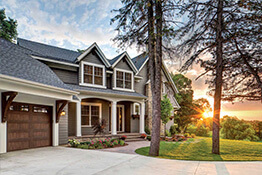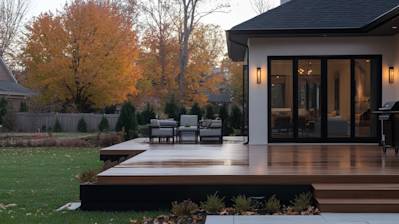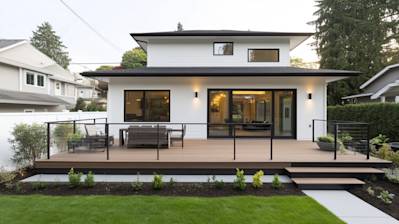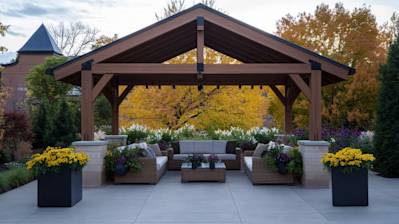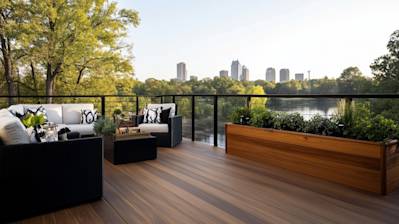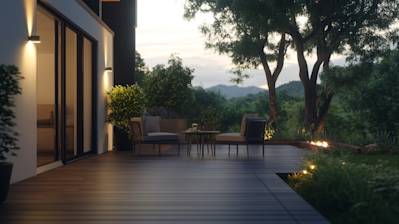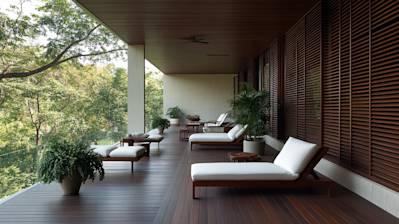When it comes to enhancing the aesthetic appeal of your outdoor spaces, especially that of your deck, the color theme assumes a critical role. With decking now available in a bewildering range of colors, it has become much easier than ever to achieve the utmost visual harmony while reinforcing the value and appeal of your home. The colors of decking can vary widely - from the rich hues of natural wood and the modern neutrality of grays to the comforting warmth of earthy colors. As you embark on your deck-enhancing endeavor, this article is your ultimate guide to help you navigate through the world of decking colors.
Embracing the Natural Tones: Wood Colors of Decking
All lovers of classic aesthetics can rejoice in the refreshing collection of wood colors of decking. Natural wood decking is a timeless choice that brings a sense of sophistication and rusticity to your outdoor spaces.
Pressure-Treated Wood Decking
One of the most common types of natural wood decking is pressure-treated wood. Standard pressure-treated wood decks often carry a light greenish hue, which eventually turns into a classic gray with time.
Cedar, Redwood, and Mahogany Decking
Cedar decks boast a vibrant amber hue, while redwood decks enchant with their reddish-brown splendor. Meanwhile, mahogany decks deliver a warm, rich tone that exudes luxury and class.
Modern and Cool: Gray Decking Colors
Gray is the new trend in decking colors. Preferred by modern homeowners who seek a sleek, minimalist space, gray decks offer a versatile canvas that combines beautifully with a wide array of outdoor furniture and plants.
Light Gray
Light gray decking color is perfect for sun-drenched decks as it does an excellent job of reflecting heat, thereby creating a cool outdoor environment. Moreover, it renders the illusion of a more spacious deck area.
Dark Gray
Dark gray decking color, on the other hand, adds depth and dimension to the outdoor area, effortlessly making a bold statement with its grounded appeal.
Drawing from the Earth: Earth-Toned Decking Colors
Earth-toned decking colors are all about celebrating the irresistible charm and warmth of mother nature. These colors pair well with most exterior color schemes and yield a soothing, welcoming ambiance.
Brown Decking
Brown decking color comes in various shades, each holding a unique appeal. There's light brown that exudes a breezy, clean look, mid-brown that delivers a serene, earthy vibe, and dark brown that is perfect for creating a dramatic and intimate outdoor setting.
Taupe Decking
Taupe decking colors strike a plush balance between gray and brown, delivering a neutral palette that spells elegance and versatility. Taupe decks complement virtually any surrounding colors, whether on the walls, plants, or garden furniture.
Choosing Your Perfect Shade: The Considerations
While decking color choices are aplenty, selecting the perfect shade for your deck is more than just about the aesthetic appeal. Here are a few aspects to consider:
-
Sun Exposure: Light colors are perfect for sunny areas as they reflect heat, keeping the deck cool. Dark colors, in contrast, are suitable for shaded deck areas as they soak in the heat and keep the area warm.
-
Surroundings: Look for a color that enhances the overall appeal of your surroundings. For example, a gray deck might flawlessly pair with a house that carries plenty of cool, neutral tones.
-
Maintenance: Darker colors show less dirt and scuffs than light colors, forecasting fewer maintenance callouts.
Final Touches: Deck Board Patterns
Remember that the way your deck boards are laid out can also impact the overall look of your outdoor area. Some popular patterns include diagonal laying for a dynamic look, herringbone pattern for a touch of sophistication, and picture-framing pattern for added visual interest and uniqueness.
Finding the perfect color for your decking isn't just about picking your favorite shade. It's about understanding how that color works with your home's exterior, natural surroundings, and the desired atmosphere for your deck. Here's to creating decks where every color comes alive in harmony!
FAQs about the Colors of Decking
Why is color selection important for decking?
The color of your decking performs a huge role in defining the overall aesthetics of your external living space. It can either create a harmonious blend with your home's outdoor theme or generate a striking contrast, bringing warmth and beauty. Additionally, certain decking colors can assist in regulating your deck's temperature.
What are the most popular colors for decking?
Although the selection of deck colors largely depends on personal style preferences, some colors are undeniably more popular among homeowners. These include various shades of brown, ranging from honey and chestnut to cherry and walnut. Additionally, grey is becoming increasingly popular for its modern and minimalistic appeal.
Are lighter decking colors better than darker ones?
There is no general preference of lighter colors over darker ones in decking. The choice primarily depends on your aesthetic preference, the theme of your external space, and also the climate. In warmer regions, lighter colors are preferred as they tend to absorb less heat compared to darker shades.
Are the colors of composite decking different from wood decking?
Yes, the hues for composite decking can be different from those of wood decking. Composite decking is able to maintain consistent colors over long periods of time, while the colors of wood decking may change due to weather elements and wear and tear.
Does the decking color fade over time?
All types of decking, whether wood or composite, are susceptible to some fading over time due to exposure to sunlight and other natural elements. However, renowned brands utilize advanced technologies to increase fade resistance and help maintain the deck's aesthetic appeal over the years.
How should I choose the correct color for my decking?
Choosing the right decking color should take into account your home's exterior color, the surrounding landscape, and your lifestyle needs. It's often suggested to use a shade which matches your indoor flooring to create a harmonious flow. You should also consider practical aspects, such as resistance to staining and heat absorption.
Can I change the color of my decking?
Yes, you can change your decking color. For wooden decks, this typically involves the process of sanding, cleaning, and repainting or staining. Composite decks, however, are trickier, as most are not intended for painting. Some high-quality composite decks can be paintable, but it's advised to consult the manufacturer beforehand.
What are the trending decking color options?
Outdoor design is continuously evolving, and so are popular decking colors. Currently, cool-toned colors are in vogue, such as light grey, silver, and blue. Earthy tones, like shades of brown and green, perpetually maintain a place in the trend charts as well.
Can the color of my decking affect its temperature?
Yes, the color of your decking can significantly affect its temperature. Darker colors tend to absorb more heat, making the deck feel hotter underfoot in sunny climates. On the other hand, lighter colors reflect more sunlight and therefore feel cooler.
Pros of Decking Colors
Visual Appeal
-
The color of deck adds to the overall aesthetic appeal of your home. A carefully chosen color can complement the exterior of your house and landscaping, giving your entire premise a harmonious and balanced feeling.
-
Choosing brighter colors for your deck can create an inviting and vibrant atmosphere, great for social gatherings or relaxing after a long day.
-
A darker deck color can provide a more refined, elegant look to your outdoor space. It can also be a good means of creating contrast against your home or garden.
-
Having an array of colors to choose from allows homeowners to personalize their decks to their taste or mood, resulting in a more satisfying and enjoyable outdoor space.
Durability and Maintenance
-
Certain deck colors can better hide dirt and stains compared to others. For example, a medium-toned deck can effectively conceal dirt and requires less frequent cleaning.
-
Darker colors are typically better at resisting fading. They absorb more of the UV light that causes decolorization, so they tend to retain their original color longer than lighter ones.
Cons of Decking Colors
Heat Absorption
-
Darker colored decks might look classy, but they absorb more heat, and can become uncomfortably hot during the summer months. This may restrict the usage of the deck during hot and sunny days.
-
Lighter colored decks are less prone to heat absorption, they reflect more sunshine and stay cooler than dark ones, but they tend to show dirt and stains more readily.
Color Fading and Maintenance
-
Depending on the material of your deck, certain colors may fade over time due to UV radiation and weather. This is more noticeable on lighter colored decks. You will need to put in a considerable amount of time and money on regular maintenance to prevent or stop the fading.
-
Low-quality colored decks will require more frequent re-coloring and maintenance which can be cost and time intensive.
Limiting Design Choices
-
Once a color is chosen and applied, it can be quite difficult, costly and time-consuming to change. This means that if you decide to change the exterior color of your home or landscaping, your deck may no longer fit in with the overall color scheme, limiting your design flexibility.
-
Dark colored decks might restrict your choice of outdoor furniture or accessories as not all shades may coordinate well together.
Verdict
Choosing decking colors depends heavily on the homeowner's personal preferences, the home's exterior colors, the landscaping around, and the climate. While there are several benefits of choosing certain decking colors, there are also inherent disadvantages. Be sure to consider the density, durability, maintenance requirements, heat-absorption level, and aesthetic appeal before you decide on the color. Ultimately, the aim is to create an inviting and comfortable outdoor space where you can spend quality time.
Summary
Choosing the right "colors of decking" can be a game-changer for your outdoor space. With plenty of options available, you can select something that complements your home's exterior design and suits your personal preference. Whether you go bold with rich browns or subtle with neutral grays, the color of your deck can elevate the aesthetic appeal of your entire property.
Remember that the colors of decking you pick will greatly influence the ambience of your outdoor living area. Warm tones can create a cozy feeling while cooler tones are perfect for a modern minimalist look. But at the end of the day, your deck should reflect your personality and style, so choose a color that provides you with that satisfaction and happiness.
Lastly, while the aesthetic aspect is significant, remember to consider your deck's longevity and maintenance. Colors of decking can have a big impact on these factors. For instance, lighter colors might show dirt and stains more, while darker tones could require more cooling during hot days. Therefore, it's essential to balance both your design goals and practical needs when choosing your decking color.
About US Quality Construction of Columbus
Welcome to US Quality Construction of Columbus, where we're committed to delivering nothing less than top-notch construction and remodeling services. Based in the vibrant city of Columbus, OH, we're proud to have served our local community with utmost dedication and professionalism for years. Whether you're envisioning a new, beautiful home transformation or aiming to bring your creative commercial space ideas to life, we've got you covered. With our experienced team that prioritizes quality, customer satisfaction, and transparency, your construction dreams might just be one project away. Explore our site to learn more!
Tags: decking colors, outdoor design, home improvement,
